The reasons for which the good old electricity in the home outlet goes beyond the limits of permissible deviations, are different. Sometimes these are temporary voltage spikes and noise spikes, sometimes they are systematic deviations beyond the limits of GOST. In the end, home appliances pay for it, instantly or slowly dying from “electrical intoxication”.
In this post we will talk about simple and inexpensive methods of "electric hygiene" depending on the type of problems in your electrical network.
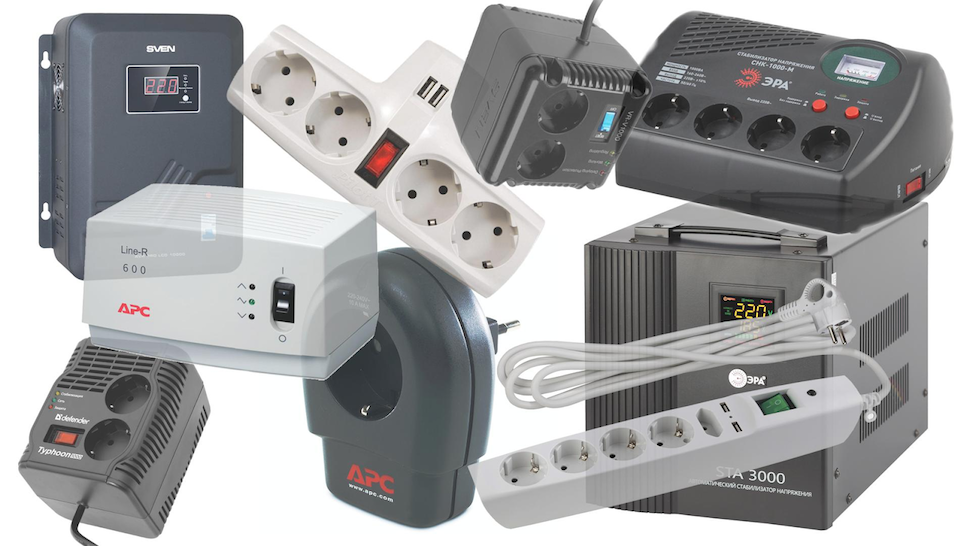
Why is all this necessary?
Only in an ideal world, the current in an electrical outlet has only two states: it is or is not. In reality, the "behavior" of electric power has an "analog" unpredictable character, unpleasantly surprising every time you expect it the least.
There are many reasons why the “mains powered” can deviate from the norm and even go beyond the standard deviations. So, the evening voltage in the network - when each outlet of each apartment includes a kettle, TV or computer - is significantly different from the voltage during night or daytime hours with a minimum load.
Another example: a citizen connected an industrial welding machine to a home network, and all neighbors in the entrance or house enjoy impulse noise in the form of strips on screens and crackling in acoustics.
In most cases, a decrease in the quality of power supply is unpredictable and inevitable due to the external nature of the source - such as, for example, pulsed power surges during a thunderstorm. Sometimes the problem is known very well - for example, a powerful hair dryer, a kettle or a vintage refrigerator, periodically sending out “electric magic” on flimsy home or office wiring, which is beyond our power to get rid of, although in some cases the problem is solved by simply tightening the contacts all the way.
The list of possible sources of problems with electricity can be continued. But whether it is sparking contacts in the stairwell or regular surges at the substation - for the owner of the “suddenly” burned out not guaranteed equipment, the result is one.
Filter filter discord
The very name of the device, the “power filter”, contains the key principle of protection: by passively filtering the input voltage. The simplest low-cost options can filter high-frequency noise using built-in inductive-capacitive elements (LC filters) or deal with impulse noise using varistor filters. More expensive items include both kinds of filters.
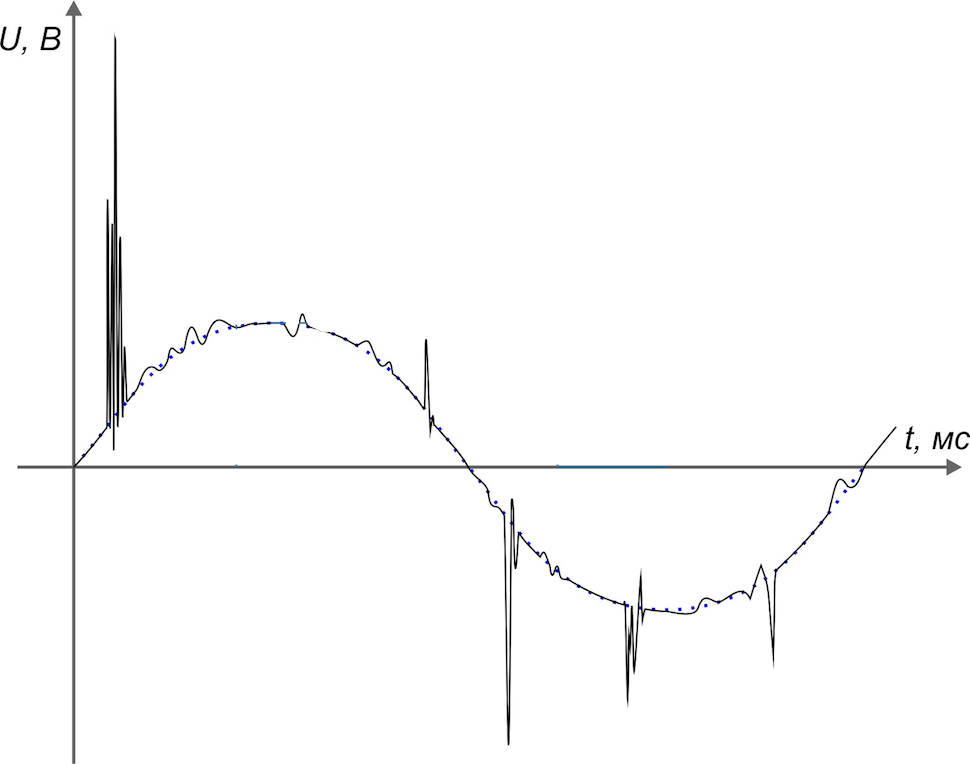 Input mains voltage with high-frequency and impulse noise
Input mains voltage with high-frequency and impulse noise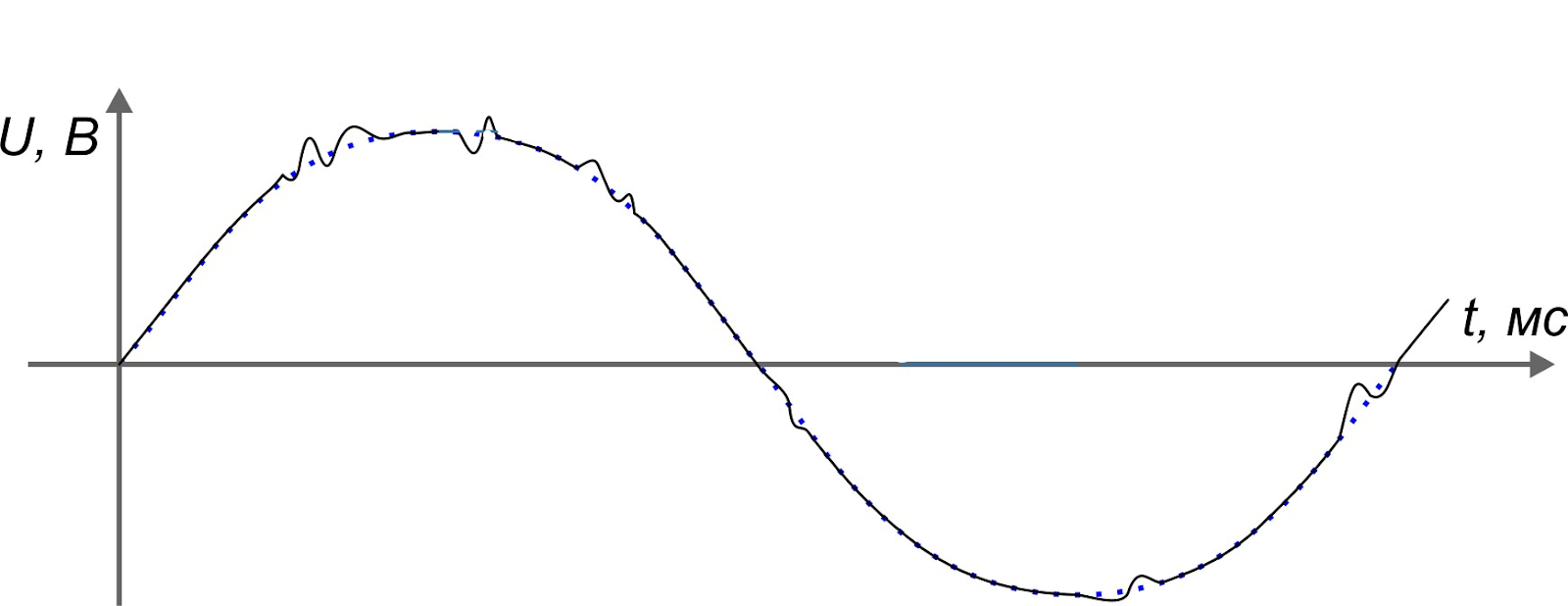 Voltage after filtering impulse noise varistors
Voltage after filtering impulse noise varistors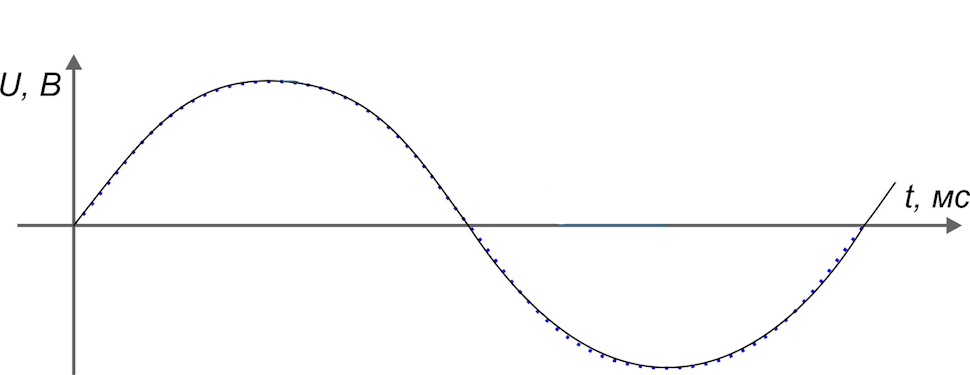 Output voltage after LC filtering high-frequency noise
Output voltage after LC filtering high-frequency noiseIn a really good surge protector there is an additional means of protection. For example, an automatic fuse that turns off power at a certain current overload. Or special metal oxide varistors that are triggered by extreme voltage spikes during a thunderstorm or in the event of a short circuit.
 ERA SF-6es-2m-B: Typical Surge Protector
ERA SF-6es-2m-B: Typical Surge ProtectorSome network filters offer additional "related services", for example, provide filtering and protection for telephone line / fax, Ethernet network and television antenna. The occurrence of such interference is not such a big rarity in old buildings, the cabling in which over many years of operation has become a multi-layered and sometimes chaotic interlacing of power and signal wires with shabby and rusted contacts. Functions of such filtering with equal success can be claimed both in the office and at home.
Stabilizer: normal flight
Unlike the network filter, which smoothes pulse and high-frequency distortions (interference) by passive means, the network stabilizer actively influences the key parameter of the power supply - voltage, compensating for its deviations.
Until recently, a voltage of 220 V ± 10% (GOST 5651-89) was considered the norm for a single-phase network; that is, any AC voltage in the range from 198 to 244 volts was considered normal. Recently, the interstate standard GOST 29322-2014 (IEC 60038: 2009) resulted in European standards came into force, according to which the mains voltage of 230 V ± 10% or from 207 to 253 V is considered standard, however, so far Nobody canceled - the standards operate in parallel, so that in general, you can take into account the approximate range of 200-250 V.
Almost all modern computer and consumer electronics are equipped with switching power supplies, which themselves are excellent stabilizers and are capable of operating in a wide range of supply voltages. For example, the vast majority of computer power supplies — both embedded in PCs and external, for laptops and tablets — are designed for global use in most countries of the world with nominal mains voltages from 110 V to 240 V. In some cases, this technique “runs "Even at a voltage of only 90-100 V. Accordingly, the reduction of the voltage in the outlet for any reason is not a hindrance for them, the boosting compensation occurs automatically.
Defender AVR Typhoon 1000: 320 W compact stabilizer and 2 socketsWith high voltage a little more difficult: even the most modern electronics is designed for a maximum of 250-260 V, but if such voltage in the supply network for some reason has become the norm (in urban conditions it is difficult to believe), of course, it is better to stabilize it by external means.
Regardless of overvoltage or undervoltage, all lovers of warm tube sound, rare vinyl turntables, music players, amplifiers and other old technology, are in a special risk group. In this case, the use of stabilizers, as they say, is not discussed.
Currently, the most popular and numerous representatives of the class of household voltage stabilizers are electronic, where the incoming current with a frequency of 50 Hz is converted into high-frequency pulses with a frequency of tens of kilohertz and is controlled by pulse-width modulation (PWM). Of the significant drawbacks of such stabilizers, it can only be noted that the sinusoid at the output of such stabilizers is far from ideal. The list of advantages is much longer: compactness, low weight, huge working range, versatility, resistance to overload, and, most importantly, an incredibly affordable price.
In addition, in retail, occasionally you can also find "classics": impressive blocks of size, stepwise reducing or raising the output voltage due to electronic or relay switching of the windings located inside a full-fledged autotransformer. Such stabilizers are bulky, have a hefty weight, but they practically do not distort the sinusoid of the input current. As a rule, stabilizers of this class are focused on powering an entire house or performing a specific task - such as powering a gas boiler, but under certain conditions such a device may turn out to be the ideal choice of audiophile.
PowerCom TCA-2000: stabilizer for 2000 VA (1000 W) and 4 socketsA good stabilizer, as a rule, is equipped with all passive filters characteristic of network filters, and also has all conceivable types of protection, including overvoltage, overload, overheating, short circuit, etc.
What you need to know when choosing a network filter
When choosing any intermediate network device - an extension cord, a surge protector, a stabilizer or an uninterruptible power supply, first of all you should remember the main rule: “electrical engineering - the science of contacts”. Beautiful labels, loud brand names, numerous indicators and USB ports should not distract from the main problem: including anything between the network and the device, we add extra pins to an already long and irregular circuit.
- Even the most advanced circuitry solutions for stabilization, filtering and protection are simply meaningless if the contacts in the sockets are cut out of a can and dangle in vain, and the soldering of connectors is made poorly. In such conditions, any load drops in the network will automatically create numerous interferences.
Power Cube PRO Line Filter
When buying, pay attention to the quality of the outlets, plugs, cables and contacts. The plugs must fit as tightly as possible into the sockets, the device cable, if present, must be reliable, from stranded wire, with high-quality insulation, designed for a sufficiently large peak current in the common-mode mode. It is very good if the outlets of the device are equipped with protective shutters, this will bring additional security in the house with preschoolers.
- Calculate in advance the number of necessary sockets for connecting equipment, so that later you do not have to fence a garden of unnecessary additional contacts from extension cords and other adapters.
A good surge protector or stabilizer may have an indication of grounding or overload, this is a useful bonus. As for the charger built into the surge protector with one or several USB ports, this is rather a pleasant trifle, somewhat affecting the price, but not related to the main function of the device.
- In the process of selecting a network filter, it is important to pay attention to the total energy of peak spurious voltage emissions (in joules), which the device is theoretically able to filter and extinguish at any time without self-destruction. However, the maximum number of joules in the filter specification is also not the ultimate truth, since a properly designed filter can “ground” some of the energy through the varistors. However, in the selection process, filter markings in joules should not be discounted.
- The next important parameter is the maximum interference current for which the filter is designed, in amperes. In addition, the surge protector can also be marked for maximum load, while it can be indicated both in amperes and in watts.
- Some manufacturers also add to the list of network filter characteristics the maximum allowable voltage (in volts), the level of attenuation of high-frequency interference for different frequencies (in decibels) and the presence of overload protection - for example, from overheating.
Finally, a number of filter parameters that determine its choice in each individual case: cable length, number of sockets, possibility of wall mounting, the presence of additional filters for a telephone line and twisted pair, the presence of USB ports, and so on.
Option 1: new building
To begin with, consider the most optimistic scenario: a newly built new building with a new substation; The wiring is made exclusively with copper with perfect installation, high-quality, not yet oxidized contacts and automatic fuses for the appropriate current.
It would seem that the voltage in the outlet should be as close as possible to the ideal sine wave. Alas, even this idyll can easily be spoiled for a couple of months by a gop-group invited by a neighbor to repair with a broken-down tool: every electric motor in each Bulgarian, a drill or a bump stop, will spark the last force to its final line by sending out “death impulses” .
These are flowers: the most active and restless tenants will periodically connect industrial welding machines to their home networks so that all neighbors in the entrance or house can “enjoy” impulse noise in the form of strips on TV and PC screens and cracks in speakers and headphones.
So, even the residents of relatively new microdistricts in large cities and cities with relatively new infrastructure are not protected from pulsed and high-frequency interference of power supply - at least of local origin.
At least the first few years of a new home will inevitably be devoted to various repairs and rebuildings. In such a situation, perhaps, the purchase of the most "powerful" network filter is not needed, but it is impossible to do anything without filtering the power voltage.
From inexpensive options, you can look at the network filters of the domestic company "Era". In its assortment there are many models differing in the level of protection and the presence of additional functions.
The most affordable and simple solution for filtering mains voltage can be called an inexpensive
ERA SF-5es-2m-I network filter. The device is made in a fireproof housing, has a cable 2 m long and is equipped with five sockets of EURO format with a grounding contact.
The maximum filter load is 2200 W (10 A), the maximum interference current is declared at the level of 7000 A, and the maximum dissipative energy is at the level of 300 J with the maximum load voltage deviation of 275 V.
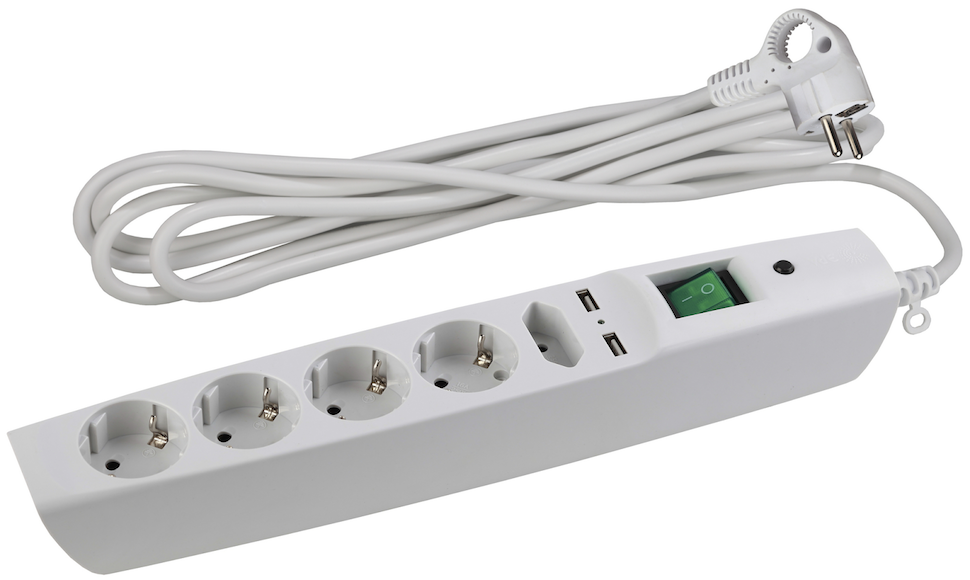 ERA SFU-5es-2m-W Surge Protector
ERA SFU-5es-2m-W Surge ProtectorThis filter is equipped with an on indicator, impulse noise filter, protection against short circuit and overheating. In addition, the device attenuates high-frequency interference (0.1–10 MHz) by 10–40 dB.
Those who are not critical to high-frequency filtering can pay attention to the
ERA USF-5es-1.5m-USB-W power filter: with similar load characteristics, maximum current (minus RF filter), this device is equipped with a switch and provides maximum energy dissipation to 125 J, as well as equipped with two built-in USB ports for charging portable equipment and has wall fasteners.
A slightly more expensive option is the ERA SFU-5es-2m-B surge filter, combining all the advantages of the two filters mentioned above, including the high-pass filter, USB ports, wall mounting, a switch and maximum energy dissipation up to 300 J, but at the same time is made in a reliable stylish black polycarbonate casing.
For those who need long cables, it makes sense to look at the Sven Optima series surge protectors for six outlets supplied at retail with a
1.8-meter ,
3-meter or
5-meter network cable. These filters are designed for a maximum load of up to 2200 W, a maximum interference current of up to 2500 A and a maximum energy dissipation of up to 150 J with a load voltage deviation of up to 250 V.
Despite the low price, they are equipped with a built-in switch, on indicator, impulse noise filter, short circuit protection and automatic overload protection.
Pilot L 1.8 m power filter from ZIS Company can be attributed to this class of devices. A feature of this filter is the presence of five sockets of the EURO standard plus one additional socket of the Russian sample, as well as support for the maximum interference current up to 2500 A and maximum dissipated energy up to 800 J.
Single-line solutions, which are present in the range of most manufacturers, stand apart among the network filters. On these filters without fail it is worth paying attention to the owners of Hi-Fi and Hi-End equipment, especially the one that was released 20 or more years ago. An “individual” power filter will allow the listener to be protected from clicks and other background sounds, while favorite amplifiers, turntables, phono-correctors and decks - from premature aging of already “not young” components.
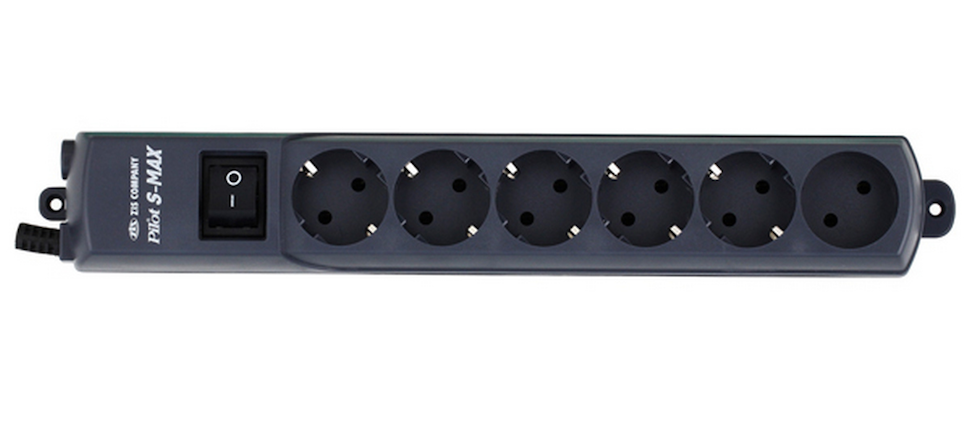 Network filter Pilot S-Max
Network filter Pilot S-MaxFor example, a single-socket network filter
Pilot BIT S with a maximum load of up to 3500 W, a maximum disturbance current of up to 10,000 A and a dissipated energy of up to 150 J will provide full protection for the equipment with a filter of impulse noise, protection against short circuits and overload.
Another interesting single-socket solution - the
APC Surge Arrest P1-RS surge protector from Schneider Electric, despite its compact dimensions, guarantees a maximum load of up to 16 A, a maximum disturbance current of up to 26,000 A and energy dissipation of up to 903 J. Such powerful protection with success It can be used as a filter adapter to a conventional multi-outlet extension cord.
Network filter APC P1-RSOption 2: to give
From the “almost perfect” conditions of urban new buildings, we will move on to less successful examples - houses with wired forms, offices, suburban houses and other cases with unstable power supply. In a special “risk group”, offices are here, because to various sources of interference typical for home users, offices are added by interference from powerful industrial air conditioners, and in some cases from industrial refrigerators and other power equipment with huge impulse emissions of starting currents.
The same APC has four or five outlets for such cases, such as
APC P43-RS or
APC PM5-RS from the Essential series. With a maximum load of up to 10 A, they provide a load shedding voltage of up to 300 V with a maximum interference current of up to 36,000 A and a maximum dissipated energy of up to 918 J.
APC SurgeArrest PM5B-RS Surge ProtectorIn addition to a fireproof enclosure, impulse noise filtering and short circuit protection, these filters are equipped with switches and euro outlets with mechanical protection.
An interesting solution to the issue of filtering and protection can also be a surge filter
Sven Platinum 1.8 m Black . The uniqueness of this filter is that, in addition to the general mechanical switch, each of its five sockets is equipped with an individual switch with a work indicator. The device is designed for a load of up to 2200 W, the maximum interference current up to 2500 A and the maximum dissipated energy up to 350 J.
Surge Protector Sven Platinum 1.8 m BlackFor perfectionists, unique Monster surge protectors are available in Russia today. The price for products of this brand is two to three times higher than similar offers from other brands, however, the use of ceramic varistors, Clean Power technology for reducing electromagnetic radiation, a circuit of additional protection and a unique appearance quite compensate for this difference.
The most versatile Monster network filter is the
Core Power 800 USB , equipped with eight euro sockets, two USB ports for charging portable equipment, and an input and a LAN output for additional protection of the Ethernet cable against impulse noise. It holds the load up to 16 A and provides dissipation of interference with energy up to 1440 J. The filter has an indication of switching on and grounding, protection against short circuits and overloads, as well as mechanical protection of sockets.
 Surge Protector Monster Core Power 800 USB
Surge Protector Monster Core Power 800 USBThe “closest relative” of this model is the
Monster Core Power 600 USB power filter, it is designed for six outlets and does not have a LAN filter, but at the same time it provides maximum dissipation of interference energy up to 1836 J.
The list of decent network filters can be continued by several reputable trademarks - such as InterStep, Uniel, Ippon, IEK, Defender, Powercom, ExeGate, etc.
When choosing a filter, the most important thing is to correctly assess the situation with the quality of power supply in your home or office, as well as determine the needs and quantity of electronics and home appliances that will be connected to the filter. For example, those who receive internet access via optics or twisted pair do not need a filter for the telephone line, which cannot be said about those who are connected to the Internet via ADSL.
In any case, the choice of a network filter deserves special attention, because the life of the equipment sometimes depends on this seemingly unimportant device;
Choosing a voltage regulator
The power line stabilizer is a device specific and much more complicated than a power filter, therefore the list of manufacturers is much shorter.
However, the names of the most popular brands are almost the same here, and the choice is somewhat simplified due to the fact that the key parameters for determining the most suitable solution are much smaller.
Yes, most power supply stabilizers contain built-in noise filters and can also be labeled with maximum dissipation energy, but the most important parameters when choosing are still the maximum load and the stabilization range of the input voltages.
It is best to classify the network stabilizers according to the maximum permissible load, and already after that, to watch the range of voltage stabilization.
In Russia, the permissible maximum load is usually normalized in watts (W) or kilowatts (kW), in other countries, in particular, in China, marking in volt-amperes (VA) or kilovolt-amperes (kVA) is adopted.
The watts of
active power and volt-amperes of
useful power are not at all identical, the latter must be multiplied by the so-called power factor, which varies from 0.6 to 1.0 for household appliances and electronics to achieve approximate equality.
In practice, they usually calculate the approximate total power of the load, and then, in order to know the desired useful power in volt-amperes, multiply it by 1.4. And vice versa: if necessary, find out the approximate load of the stabilizer in watts multiplied by a factor of 0.7.
And one more useful practical advice: after calculating the total maximum power of the assumed stabilizer load, add another 25% to the result; a small margin will not only avoid overloading in the future when new devices are connected, but also eliminates the stabilizer from working in the limiting mode, where efficiency drops noticeably.
Choosing a stabilizer, you should also pay attention to the presence of a “smart” Bypass mode (“bypass”): at the nominal mains voltage, such a device will not waste energy and will be put into operation only when there is a real need for it.
When determining the maximum allowable load power of a network voltage regulator, one should look at its characteristics, and not at the name: it’s not at all the fact that the numbers in the name have at least some practical relation to the power of the device.
To stabilize the mains voltage with a relatively small load - up to 300 W - there are very interesting solutions for Sven. Compact stabilizers are made in an unusual “cubic” design and have a fairly wide range of voltage stabilization - usually in the range from 150 to 280-295 V.
Here is the case when you should not trust the figures in the name and read the characteristics very carefully: the maximum load of the
Sven VR-V 600 stabilizer is 200 W, and the maximum load of the
Sven Neo R 600 is 300 W.
Both "cubes" have protection against overload and short circuit, designed for maximum current interference up to 6500 A and dissipated energy up to 220 J, and both are equipped with sockets with mechanical protection.
For more powerful loads, the company manufactures the
Sven VR-V1000 stabilizer , which provides connectivity technology up to 500 watts. It is already possible to connect to such a “cube” not only a home audio system, but also additional devices, such as a TV set, game console, personal computer.
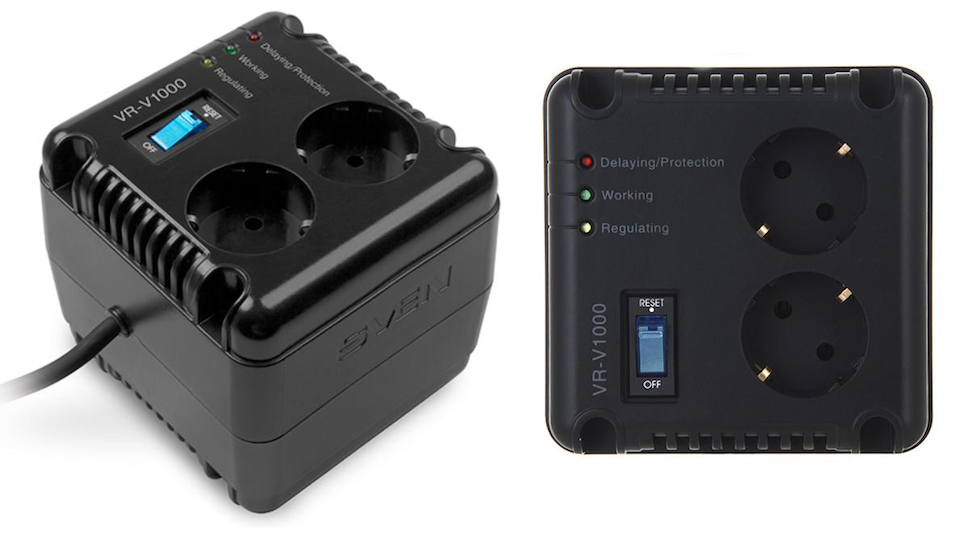 Power conditioner Sven VR-V1000
Power conditioner Sven VR-V1000In the model range of voltage stabilizers manufactured by Schneider Electric there are two popular
APC LS1000-RS Line-R and
APC LS1500-RS Line-R models, designed for loads up to 500 W and 750 W, respectively. Both stabilizers operate with input voltages in the range of 184-248 V, equipped with operating voltage and overload indicators, impulse noise filters, protection against short circuits and overloads.
Voltage stabilizer APC LS1000-RS Line-RDo not be lazy before buying and also check the maximum operating voltage of the stabilizer - if this parameter is really critical for your network. For example, the APC LS1500-RS Line-R stabilizer is designed for an input operating voltage range of 184-248 V, while the APC Line-R 600VA Auto model, although designed for lower power, up to 600 W, at the same time provides a much wider range of stabilization of input voltages, from 150 to 290 V, which, in particular, explains its higher price.
Voltage stabilizer APC Line-R 600VA AutoVoltage stabilizers from 1000 W (1 kW) and above should be divided into a separate category designed to service powerful office equipment, household equipment for homes (for example, for heating boilers) or voltage stabilization throughout the house. For such purposes, they often use powerful systems with autotransformers.
Sven is one of the few companies who manufactures and sells stabilizers with an autotransformer in Russia, designed for a significant load and at the same time having an affordable price. So, for example, the
Sven AVR PRO LCD 10000 model copes with a load of up to 8 kW in the stabilization range from 140 to 260 V - an excellent choice for connecting the entire country house.
Power conditioner Sven AVR PRO LCD 10000A very large range of powerful compact stabilizers produces the previously mentioned "Era".
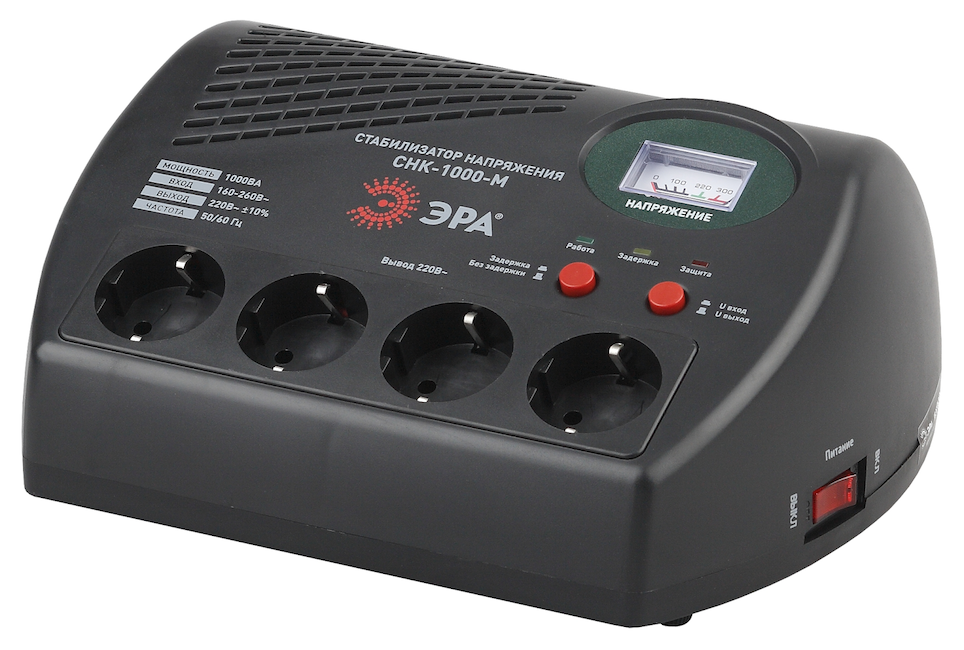 Voltage stabilizer ERA SNK-1000-M
Voltage stabilizer ERA SNK-1000-MPay attention to the labeling of its products: in the name of the stabilizers, as a rule, the useful power in watt-amperes is indicated. For example, the
ERA stabilizer
SNK-1000-M is designed for 1000 VA, that is, with it you can safely lay the maximum active load up to 700 watts.
Voltage stabilizer ERA STA-3000For powering a powerful home load - from 3000 W and more, stabilizers with relay load regulation are also excellent. They are affordable, compact, have a wide range of stabilization - from 140 to 270 V and are equipped with all kinds of protection.
Voltage stabilizer ERA STA-3000The most affordable model of this series, the
ERA STA-3000 , will withstand a load of up to 3 kW and will automatically shut off at a long-term stable mains voltage. , - .
, , . , .